england

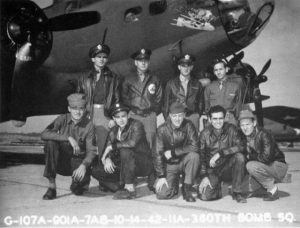 Every war has its casualties…it is an inevitable part of battle. World War II was no different, and in fact it was the deadliest war in world history, with casualties between 40,000,000 and 72,000,000. On average, 6,600 American servicemen died per month during World War II, about 220 a day. By the end of the war, over 40,000 airmen were killed in combat theatres and another 18,000 wounded. Some 12,000 missing men were declared dead, including a number liberated by the Soviets but never returned. More than 41,000 were captured, half of the 5,400 held by the Japanese died in captivity, compared with one tenth in German hands. As with any part of the war, being an airman in World War II was simply a very dangerous business.
Every war has its casualties…it is an inevitable part of battle. World War II was no different, and in fact it was the deadliest war in world history, with casualties between 40,000,000 and 72,000,000. On average, 6,600 American servicemen died per month during World War II, about 220 a day. By the end of the war, over 40,000 airmen were killed in combat theatres and another 18,000 wounded. Some 12,000 missing men were declared dead, including a number liberated by the Soviets but never returned. More than 41,000 were captured, half of the 5,400 held by the Japanese died in captivity, compared with one tenth in German hands. As with any part of the war, being an airman in World War II was simply a very dangerous business.
Over the years of World War II, there were many stories of men falling from their planes either from attack or accident. I’m sure some were just stories, but this is a true story. Staff Sergeant Alan Magee was born on January 13, 1919 in Plainfield, New Jersey, the youngest of six children of Resue and Doretta (Winn) Magee. Alan grew to be a short 5’7″ tall. That is short for a man, but slightly tall for a ball turret gunner on a B-17 bomber. Like many men, Alan joined the service right after the attack on Pearl Harbor. He was assigned as a ball turret gunner with the 303rd Bomb Group, 360th Squadron stationed at RAF Molesworth, which is a Royal Air Force station located near Molesworth, Cambridgeshire, England.
At 5’7″ inches, Magee was barely small enough to fit in the B-17’s ball turret. The ball turret was a cramped, donut shaped plastic glass and metal turret on the belly of the bomber. It was such a tight fit that a gunner’s knees were practically against his chest. Magee had to leave his parachute on the deck of the four engine Flying Fortress. That fact would prove to be detrimental. On January 3, 1943, Magee was assigned to a B-17, nicknamed “Snap! Crackle! Pop!” They were on a bombing run during the daytime over Saint Nazaire, France, also known at “Flack City,” when German fighters shot off a part of the right wing, causing the plane to enter a deadly spin. This was Magee’s seventh mission. That was an amazing feat in and of itself, because the life expectancy of a ball turret gunner in World War II was 12 minutes. It was really considered a suicide position on the plane. Oddly too, Magee was one of the oldest members of the 10 man crew at 24 years. The pilot, Captain Arthur Adams, was only 19, and this was only his third combat mission.
Magee was wounded in the attack, but managed to escape the ball turret, scrambling back into the cabin for his parachute. The only problem was that his parachute had been damaged and was totally useless, so having no other choice, Magee leapt from the spiraling plane without his parachute, losing consciousness rapidly because of the altitude. During his fall from the plane, Magee asked God to save his life. “I don’t wish to die because I know nothing of life,” was his appeal to God. Then, he totally lost consciousness and crashed through the glass roof of the Saint Nazaire train station. Eyewitnesses watched in horror as Magee came through the skylight. When he regained consciousness, Magee said to his captors: “Thank God I’m alive.” Magee’s injuries included 28 shrapnel wounds. A lung and kidney were hit. His nose and an eye were ripped open. His broken bones included his right leg and ankle. A right arm was nearly severed. The Germans decided that anyone who could miraculously survive such a fall deserved “real special attention.” It is thought that he fell over four miles before crashing through the glass roof. Some said they thought that the glass roof lessened Magee’s impact, and rescuers found him still alive on the floor of the station. It is my belief that God sent His angels to break the fall, because a 20,000 foot into a soft field can be fatal, so it is a miracle that he fell through a glass roof onto a concrete floor and lived. Magee regained consciousness in the first aid station before being transferred to the local hospital. “I owe the German military doctor who treated me a debt of gratitude,” said Magee. “He told me, ‘We are enemies, but I am first a doctor and I will do my best to save your arm.’” The doctor saved Magee’s arm and tended his other injuries, but unfortunately, Magee never found out the doctor’s name, so he couldn’t thank him. Staff Sargent Magee was taken as a POW and given continued medical treatment for his injuries by his captors. Magee was rescued in May 1945, and received the Air Medal for meritorious conduct and the Purple Heart. When the war was over, Magee got his pilot’s license and enjoyed flying. He worked a variety of jobs in the airline industry, and retired in 1979. He then moved to Northern New Mexico.

 The people of Saint Nazaire, France honored Magee and the crew of his bomber on January 3rd, 1993 by erecting a six foot tall memorial to them. Alan Magee passed away in San Angelo, Texas on December 20th, 2003, at 84 from stroke and kidney failure. With the German doctors’ help, Magee fully recovered. Magee later hiked and backpacked and “led a pretty good life.” Two of his crewmen also survived. In all, 75 airmen died, seven U.S. planes were destroyed and 47 were damaged that day.
The people of Saint Nazaire, France honored Magee and the crew of his bomber on January 3rd, 1993 by erecting a six foot tall memorial to them. Alan Magee passed away in San Angelo, Texas on December 20th, 2003, at 84 from stroke and kidney failure. With the German doctors’ help, Magee fully recovered. Magee later hiked and backpacked and “led a pretty good life.” Two of his crewmen also survived. In all, 75 airmen died, seven U.S. planes were destroyed and 47 were damaged that day.
 Anytime a nation’s leader is killed, it’s a disaster, no matter how they died, but it is not so common for the disaster to still be felt when their child is killed, although the nation naturally feels a degree of collective sadness. In a monarchy, however, things are different. The child of the current king stands to be the next leader. These days, having a girl be the next in line for the throne is not a problem, in most nations, but that was not the case in England in 1120. At the time, the king of England was King Henry I. The Norman dynasty had not been in power very long, and the King Henry I was very eager to have the line continue on. His problem was solved with the birth of his only legitimate son, William the Aethling, who was called by the Saxon princely title to stress that his parents had united both Saxon and Norman Royal Houses. William was a warrior prince who, even at the age of seventeen, fought alongside his father to reassert their rights in their Norman lands on the Continent. As was common with kings, especially in that era, and maybe not so unusual in this era, the king had multiple concubines, and so several illegitimate children too. He did have a legitimate daughter named Matilda, but the throne belonged to his son. His illegitimate children were Richard, and oddly, a second Matilda. All seemed right in his world.
Anytime a nation’s leader is killed, it’s a disaster, no matter how they died, but it is not so common for the disaster to still be felt when their child is killed, although the nation naturally feels a degree of collective sadness. In a monarchy, however, things are different. The child of the current king stands to be the next leader. These days, having a girl be the next in line for the throne is not a problem, in most nations, but that was not the case in England in 1120. At the time, the king of England was King Henry I. The Norman dynasty had not been in power very long, and the King Henry I was very eager to have the line continue on. His problem was solved with the birth of his only legitimate son, William the Aethling, who was called by the Saxon princely title to stress that his parents had united both Saxon and Norman Royal Houses. William was a warrior prince who, even at the age of seventeen, fought alongside his father to reassert their rights in their Norman lands on the Continent. As was common with kings, especially in that era, and maybe not so unusual in this era, the king had multiple concubines, and so several illegitimate children too. He did have a legitimate daughter named Matilda, but the throne belonged to his son. His illegitimate children were Richard, and oddly, a second Matilda. All seemed right in his world.
King Henry I was king from August 2, 1100, until his death on December 1, 1135, and expected that his son, Prince William would take his place as king upon his death. Then disaster struck on the November 25, 1120. This was a disaster that would have a dramatic effect, not only on the families of those involved, but on the very fabric of English Government. After a successful battle in 1119, which brought the defeat of King Louis IV of France, and the humiliation at the Battle of Brémule, the King and his entourage were headed home to celebrate. The king was offered a fine ship, the White Ship to travel home in, but he declined because he had already made other arrangements. He suggested that his son and some of the other men could talk the journey on the White Ship.
As the heir to the throne, Prince William attracted the cream of society to surround him. His entourage was to include some three hundred fellow passengers…140 knights and 18 noblewomen, his half-brother, Richard, his half-sister, Matilda the Countess of Perche; his cousins, Stephen and Matilda of Blois, the nephew of the German Emperor Henry V, the young Earl of Chester and most of the heirs to the great estates of England and Normandy. The passengers were all in a mood to celebrate, and asked the Prince for drinks. The prince had brought wine aboard the ship by the barrel-load to help with the festivities. Before long the both passengers and crew became highly intoxicated. Some even left the shop when things started getting abusive.
The people who remained were drunk, and decided that it would be a great idea to try to catch the ship the king was on. The king’s ship had already sailed out into the English Channel.  The people kept pushing the captain to accept the challenge. The captain was sure that his ship could catch the king’s ship, so they set out that evening, and immediately struck a rock in the channel as they left. The ship began to sink, and Prince William was safely in a boat, but he heard his half-sister, Matilda screaming for help. So he left the boat to rescue her. The boat he was in was hit by a group of desparate passengers, and swamped. Prince William was lost and drown. The nation was devastated, and when King Henry I tried to get them to accept his legitimate daughter, Matilda, but they didn’t want to and when the king died, Matilda and her husband found themselves fighting for the throne in a war known as The Anarchy.
The people kept pushing the captain to accept the challenge. The captain was sure that his ship could catch the king’s ship, so they set out that evening, and immediately struck a rock in the channel as they left. The ship began to sink, and Prince William was safely in a boat, but he heard his half-sister, Matilda screaming for help. So he left the boat to rescue her. The boat he was in was hit by a group of desparate passengers, and swamped. Prince William was lost and drown. The nation was devastated, and when King Henry I tried to get them to accept his legitimate daughter, Matilda, but they didn’t want to and when the king died, Matilda and her husband found themselves fighting for the throne in a war known as The Anarchy.
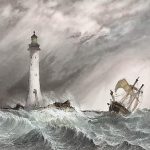
 As lighthouses go, Eddystone lighthouse is really quite different than most. The first Eddystone lighthouse was completed in 1699, and was the world’s first open ocean lighthouse, although the Cordouan lighthouse preceded it as the first offshore lighthouse. The Eddystone Lighthouse is on the dangerous Eddystone Rocks, 9 statute miles south of Rame Head, England, United Kingdom. While Rame Head is in Cornwall, the rocks are in Devon. Putting a lighthouse in the open ocean was a rather dangerous undertaking, but it was also an important lighthouse, because of the rocks it sat on. Without a lighthouse there, ships would run aground on the rocks.
As lighthouses go, Eddystone lighthouse is really quite different than most. The first Eddystone lighthouse was completed in 1699, and was the world’s first open ocean lighthouse, although the Cordouan lighthouse preceded it as the first offshore lighthouse. The Eddystone Lighthouse is on the dangerous Eddystone Rocks, 9 statute miles south of Rame Head, England, United Kingdom. While Rame Head is in Cornwall, the rocks are in Devon. Putting a lighthouse in the open ocean was a rather dangerous undertaking, but it was also an important lighthouse, because of the rocks it sat on. Without a lighthouse there, ships would run aground on the rocks.
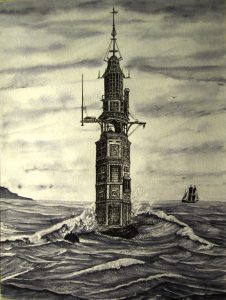
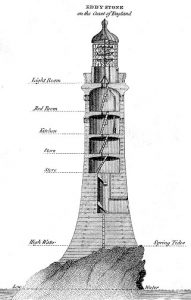
The Eddystone lighthouse fell to disaster three times, and was rebuilt threes times. The first disaster came just four years later, when the Great Storm of 1703 took with it, the first Eddystone lighthouse. The first and second lighthouses were constructed of wood. This was the material available at the time. It was also the wooden construction that made the lighthouse susceptible to the distructive storm and the fire that destroyed the first and second lighthouses…the storm in 1703 and the fire in 1755. The third lighthouse is often called Smeaton’s lighthouse. It was recommended by the Royal Society, civil engineer John Smeaton and was modeled in the shape on an oak tree, and built of granite blocks. He pioneered hydraulic lime, a concrete that cured under water, and developed a technique of securing the granite blocks using dovetail joints and marble dowels. Construction started in 1756 at Millbay and the light was first lit on October 16, 1759. It was state of the art in 
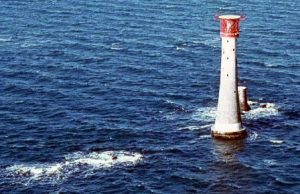 its time. It stood until 1877, when the rocks eroded enough to cause the lighthouse to rock from side to side in the waves, so it was deemed unsafe. The fourth and current lighthouse was built in April of 1879, and was designed by James Douglass, using Robert Stevenson’s developments of Smeaton’s techniques. By April 1879 the new site, on the South Rock was being prepared during the 3½ hours between ebb and flood tide. This current lighthouse is shorter and has a flat top, that is used to land helicopters.
its time. It stood until 1877, when the rocks eroded enough to cause the lighthouse to rock from side to side in the waves, so it was deemed unsafe. The fourth and current lighthouse was built in April of 1879, and was designed by James Douglass, using Robert Stevenson’s developments of Smeaton’s techniques. By April 1879 the new site, on the South Rock was being prepared during the 3½ hours between ebb and flood tide. This current lighthouse is shorter and has a flat top, that is used to land helicopters.
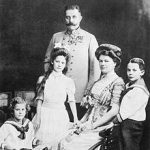
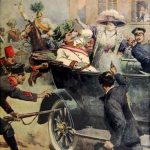 It’s amazing to me that one act of hate can bring so many people to war, but that was what happened with World War I. On June 28, 1914, Archduke Franz Ferdinand of Austria, and his wife, Sophie, Duchess of Hohenberg, were assassinated by a Serbian nationalist in Sarajevo, Bosnia. The assassin, Gavrilo Princip was an ethnic Serb and Yugoslav nationalist from the group Young Bosnia, which was supported by the Black Hand, a nationalist organization in Serbia. The outraged Austrian people and its government threatened mobilization of troops to seek vengeance for their beloved leader and his family.
It’s amazing to me that one act of hate can bring so many people to war, but that was what happened with World War I. On June 28, 1914, Archduke Franz Ferdinand of Austria, and his wife, Sophie, Duchess of Hohenberg, were assassinated by a Serbian nationalist in Sarajevo, Bosnia. The assassin, Gavrilo Princip was an ethnic Serb and Yugoslav nationalist from the group Young Bosnia, which was supported by the Black Hand, a nationalist organization in Serbia. The outraged Austrian people and its government threatened mobilization of troops to seek vengeance for their beloved leader and his family.
The crisis escalated as the conflict between Austria-Hungary and Serbia came to involve Russia, Germany, France, and ultimately Belgium and Great Britain. By mid-August of 1914, the crisis had become a full blown war, with Germany, Austria Hungary and the Ottoman Empire, known as the Central Powers, against Great Britain, France, Russia, Italy and Japan, the Allied Powers. The United States would also enter the war as a part of the Allied Powers in 1917. Other factors came into play during the diplomatic crisis that preceded the war, such as misperceptions of intent in that Germany believed that Britain would remain neutral, the belief that war was inevitable, and the speed of the crisis, which was exacerbated by delays and misunderstandings in diplomatic communications. The four years of the Great War…as it was dubbed…saw unprecedented levels of carnage and destruction, thanks to grueling trench warfare and the introduction of modern weaponry such as machine guns, tanks and chemical weapons. By the time World War I ended in the defeat of the Central Powers in November 1918, more than 9 million soldiers had been killed and 21 million more wounded.
Evil exists in this world, and it gets worse every day, and assassinations are not new. Chanakya, 350–283 BC, an Indian teacher, philosopher and royal advisor, wrote about assassinations in detail in his political treatise Arthashastra. Later, his student Chandragupta Maurya, the founder of the Maurya Empire of India, made use of assassinations against some of his enemies, including two of Alexander’s generals Nicanor and Philip. I suppose it should not be a surprise, yet every assassination brings with it shock, fear, and rage. 
 Countless wars have been fought over one nation’s ruler being killed by someone from another nation. War will be a part of our world until the end of time, but that in no way lessens the worry, fear, and sadness that war always brings. Still, like the Allies of World War I, we cannot let one group or nation hold power over another group or nation…which also explains the need to destroy ISIS.
Countless wars have been fought over one nation’s ruler being killed by someone from another nation. War will be a part of our world until the end of time, but that in no way lessens the worry, fear, and sadness that war always brings. Still, like the Allies of World War I, we cannot let one group or nation hold power over another group or nation…which also explains the need to destroy ISIS.
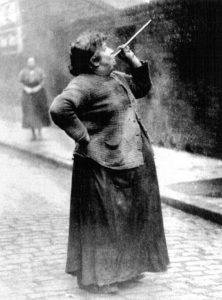 For those of us who have to set an alarm to get up for work, or whatever else one might need an alarm for, the alarm clock truly is not our friend. Whether you had a good night’s sleep or not, really doesn’t matter either. You also know that if the power goes off, or you just don’t happen to hear that alarm, because you are a heavy sleeper…well, you’re going to be late, and your boss is not going to be happy. That alarm going off is always annoying. Nevertheless, we have somewhere we need to be, so that incessant, obnoxious, blaring alarm is a necessity.
For those of us who have to set an alarm to get up for work, or whatever else one might need an alarm for, the alarm clock truly is not our friend. Whether you had a good night’s sleep or not, really doesn’t matter either. You also know that if the power goes off, or you just don’t happen to hear that alarm, because you are a heavy sleeper…well, you’re going to be late, and your boss is not going to be happy. That alarm going off is always annoying. Nevertheless, we have somewhere we need to be, so that incessant, obnoxious, blaring alarm is a necessity.
So, what did people do before alarm clocks? They still had to be to work on time, but if they were a person who did not wake up at the crack of dawn, or to the rooster crowing, what then? Now imagine that your only alarm clock is the sun. If your room is dark, you could have a big problem. Well, there was a fix for that. During the early days of the Industrial Revolution and lasting into the beginnings of the 20th Century, as late as the 1920’s, workers had to get to work on time, and there were no alarm clocks. That’s where the “Knocker-Up” or “Knocker-Upper” came in. Don’t laugh, it was a real occupation in England and Ireland in the days before alarm clocks were affordable or reliable. A Knocker-up’s whole job was to go to the homes of the workers, and wake them up by shooting a pebble through a long tube, usually made of bamboo, and hitting the window pane to wake them up. Some used a long stick, and I can see that it might be helpful if the client was a particularly heavy sleeper. A few whacks on the window sill would wake most people up. The knocker-upper was required to stay outside the house and continue this action until the worker came to the window to show that they were up and would not go back to sleep. In return for their services, the knocker-up’s clients paid them a few pence a week. Not a high paying job for sure. The knocker-ups were usually elderly men and women, or sometimes even the police, because it was a way to supplement their income, as they could do it on their morning patrols. 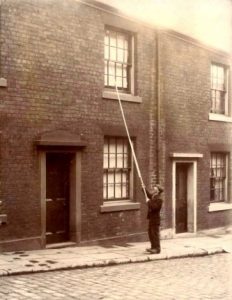
As alarm clocks became readily available, the knocker-ups were no longer needed. Nevertheless, like many other occupations of old, that no longer exist, these have their origins deeply rooted in history when people worked many varying trades and had to improvise to accomplish their tasks. Some of these professions are not what historians or genealogists consider to be mainstream work, but they are a rather interesting thing to look back on. I think it would be odd to have such a strange occupation, but I can see that it was necessary, and it wouldn’t require much time out of your day. Still, one question remains for me. Who was supposed to wake up the knocker-up? They would obviously have to be awake before the others needed to be, and if they were like me, getting me up early is not in anyone’s best interest…just ask my husband, if he should wake me up before the alarm goes off. While this may have been an honorable occupation in those days, I think it would not have been the occupation for me.
 Before scientists learned how to predict the weather, and before the weather predicting equipment came into being, people often found themselves outside, without any place to get under cover, during some really bad storms. Such was the case on Monday, April 13, 1360…later dubbed Black Monday, when a hail storm killed approximately 1,000 English soldiers in Chartres, France. England and France were in the middle of the Hundred Years’ War. The war began in 1337, and by 1359, King Edward III of England was pushing forward to conquer France. In October he sent a massive force across the English Channel to Calais. The French wouldn’t fight back, but rather stayed behind protective walls that Winter, allowing the King Edward’s men to pillage the countryside.
Before scientists learned how to predict the weather, and before the weather predicting equipment came into being, people often found themselves outside, without any place to get under cover, during some really bad storms. Such was the case on Monday, April 13, 1360…later dubbed Black Monday, when a hail storm killed approximately 1,000 English soldiers in Chartres, France. England and France were in the middle of the Hundred Years’ War. The war began in 1337, and by 1359, King Edward III of England was pushing forward to conquer France. In October he sent a massive force across the English Channel to Calais. The French wouldn’t fight back, but rather stayed behind protective walls that Winter, allowing the King Edward’s men to pillage the countryside.
Then in April of 1360 King Edward’s forces burned the Paris suburbs and marched  toward Chartres. The night of April 13, while they were camped outside the town, planning a dawn attack, a sudden storm developed. Lightning struck, killing several soldiers, and hailstones began pelting the men, and scattering the horses. One man described it as “a foul day, full of myst and hayle, so that the men dyed on horseback” Two of the English leaders were killed and the troops panicked…they had no shelter from the storm. They were at it’s mercy. King Edward’s forces suffered heavy losses that some of the men saw as a sign from God, that they should not be fighting against France. King Edward was convinced that they needed to negotiate peace with the French, and on May 8, 1360, the Treaty of Bretigny was signed, marking the end of the first phase of the Hundred Years’ War. King Edward renounced all claims to the throne of France, but he was given control of the land in the north of the country. Nine years later, fighting resumed
toward Chartres. The night of April 13, while they were camped outside the town, planning a dawn attack, a sudden storm developed. Lightning struck, killing several soldiers, and hailstones began pelting the men, and scattering the horses. One man described it as “a foul day, full of myst and hayle, so that the men dyed on horseback” Two of the English leaders were killed and the troops panicked…they had no shelter from the storm. They were at it’s mercy. King Edward’s forces suffered heavy losses that some of the men saw as a sign from God, that they should not be fighting against France. King Edward was convinced that they needed to negotiate peace with the French, and on May 8, 1360, the Treaty of Bretigny was signed, marking the end of the first phase of the Hundred Years’ War. King Edward renounced all claims to the throne of France, but he was given control of the land in the north of the country. Nine years later, fighting resumed  when the King of France claimed that King Edward had not honored the treaty. the last phase of the Hundred Years’ War finally ended in 1453.
when the King of France claimed that King Edward had not honored the treaty. the last phase of the Hundred Years’ War finally ended in 1453.
Hailstones have long been known to be very deadly. The larger the stone, of course, the more deadly it is. Some have been known to crush the roofs of cars. The largest hailstone recorded in modern times was found in Aurora, Nebraska. It was seven inches in diameter, about the size of a soccer ball. Hail typically falls at about 100 miles per hour, which explains why getting hit with one can really hurt you, no matter how small the stone might be, and why huge hailstones would mean instant death.
 Imagine a people so dedicated to bringing their people home to be given a proper burial, that they would search for 31 years for a submarine that went missing with its 69 crew members, all considered lost sons of a nation. I know that many people wait years and never give up hope for the return of the remains of soldiers lost in battle, but this was a little bit different. The meant extensive searches and great expense…nevertheless, it was considered worth the cost. Imagine such a nation. Who would you think of? The United States maybe, or England? No, it is Israel.
Imagine a people so dedicated to bringing their people home to be given a proper burial, that they would search for 31 years for a submarine that went missing with its 69 crew members, all considered lost sons of a nation. I know that many people wait years and never give up hope for the return of the remains of soldiers lost in battle, but this was a little bit different. The meant extensive searches and great expense…nevertheless, it was considered worth the cost. Imagine such a nation. Who would you think of? The United States maybe, or England? No, it is Israel.
The submarine, INS Dakar was originally known as HMS Totem. It was built at the height of World War II by H.M. Dockyard in Great Britain. It was commissioned as the HMS Totem by the British navy in 1943. After the war ended, the submarine was modified, adding 12 feet to its length and removing some of its gun decks. The submarine was then sold to Israel along with two others in 1965. On November 10, 1967, the Israeli Navy officially launched Dakar. The submarine was tested in Scotland, and scheduled to go to Haifa, Israel for an official ceremony in early February, 1968. The crew had been ordered to check in daily, and they followed the orders implicitly. On January 24, 1968, Dakar passed the island of Crete and radioed its position for the last time. One additional signal came from Dakar just after midnight on January 25, 1968 and then…nothing. That was 48 years ago today.
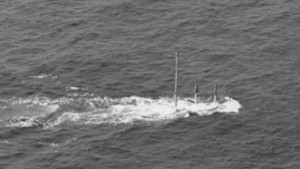
Israel launched 25 search missions over the 31 years following the loss of Dakar, but to no avail. The only sign of the submarine was one of her locator buoys that washed ashore off the coast of Khan Yunis a year after Dakar’s disappearance. Using that clue and the technology available at the time, those search missions resulted in the search of most of the Mediterranean Sea. The odd thing was that the searches never included the actual route that Dakar would have taken to Haifa. When the buoy was discovered, it was estimated that Dakar was 50 to 70 miles off course…hence the searches in the wrong places. Then, on 9 May 1999 two charted sea vessels arrived to finally search area along the original route. The designated search frames box area was approximately 60 nautical miles long, nearly 8 nautical miles wide and contained 16 search lanes. With a speed of 2 knots per hour it takes between 30 to 40 hours to monitor the sea bed of each search lane. Searching was conducted using the AMS-60, a wide-swath sonar and the REMORA 6000, a remotely operated vehicle equipped with both video and still cameras. On May 24th, in the evening, sonar detected a large body on the sea floor, along with several smaller bodies nearby. They launched the ROV at 7:00 on May 28th, after 3 days of weather delays, and finally found the Dakar four hours later.
There has been much speculation as to what caused the sinking and inevitable implosion of Dakar. Some say it  was a small leak that made control become impossible, but one Egyptian admiral has a different story to tell. Mohammed Abed el-Majid Azeb told various Egyptian sources that his crew identified the Israeli submarine during a training exercise. He decided to attack the vessel, which was in Egyptian territorial waters and and declared war on it. According to the report, Egyptian military commentators have suggested that the submarine was damaged by an Egyptian depth-charge and had to submerge, which could have been the leak they experienced. It’s hard to say after all these years, and we may never know, but I find it very interesting that the Israeli government would not give up until it could bring those lost sons home for a proper burial.
was a small leak that made control become impossible, but one Egyptian admiral has a different story to tell. Mohammed Abed el-Majid Azeb told various Egyptian sources that his crew identified the Israeli submarine during a training exercise. He decided to attack the vessel, which was in Egyptian territorial waters and and declared war on it. According to the report, Egyptian military commentators have suggested that the submarine was damaged by an Egyptian depth-charge and had to submerge, which could have been the leak they experienced. It’s hard to say after all these years, and we may never know, but I find it very interesting that the Israeli government would not give up until it could bring those lost sons home for a proper burial.
 Since my dad was stationed in England during World War II, and because many of my ancestors come from England, I am interested in all things English. Of course, that doesn’t mean that I know everything about England, and I think it would be pretty difficult to do that with any country, including the country I live in…the United States. That said, I learned something about England today. England is an island nation as most people know, and that can make travel to mainland Europe difficult and expensive. Travel to Hawaii would be a good example of that, and Hawaii isn’t even it’s own nation. Nevertheless, most of us have to save up our money to make the trip to Hawaii.
Since my dad was stationed in England during World War II, and because many of my ancestors come from England, I am interested in all things English. Of course, that doesn’t mean that I know everything about England, and I think it would be pretty difficult to do that with any country, including the country I live in…the United States. That said, I learned something about England today. England is an island nation as most people know, and that can make travel to mainland Europe difficult and expensive. Travel to Hawaii would be a good example of that, and Hawaii isn’t even it’s own nation. Nevertheless, most of us have to save up our money to make the trip to Hawaii.
So, what does that have to do with England, you might ask. Well…everything. While an alternate mode of transportation to get to Hawaii…other than ship or plane, is not feasible for Hawaii…for England, maybe it could be. As early as the days of Napoleon Bonaparte, in 1802, people were looking for a way to connect England to France. Nothing came of those early suggestions, because the necessary technology was not available until the 20th century. The proposal was that since England and France were no longer at war, they should permanently connect their countries by way of a tunnel. The Channel Tunnel, later dubbed the Chunnel runs from Folkestone, England to Calais, France. The tunnel is 31 miles across, but in total there are 95  miles of tunnels. There are two railway tunnels, and a service tunnel. The work began on in 1986, and took four years to connect the two sides. Approximately 13,000 workers dug the 95 miles of tunnels at an average depth of 150 feet below sea level. Eight million cubic meters of soil were removed, at a rate of about 2,400 tons per hour. When it was finished, the Chunnel would have three interconnected tubes, including one rail track in each direction and one service tunnel. It cost $15 billion to complete.
miles of tunnels. There are two railway tunnels, and a service tunnel. The work began on in 1986, and took four years to connect the two sides. Approximately 13,000 workers dug the 95 miles of tunnels at an average depth of 150 feet below sea level. Eight million cubic meters of soil were removed, at a rate of about 2,400 tons per hour. When it was finished, the Chunnel would have three interconnected tubes, including one rail track in each direction and one service tunnel. It cost $15 billion to complete.
Most of us don’t give much thought to tunnels, but when it comes to underwater tunnels…well, that is just different. Of course, we all know of the Holland Tunnel that connects New York and New Jersey, but that tunnel isn’t nearly as long as the Chunnel. The Holland Tunnel is a little over a mile and a half, which pales by comparison to the Chunnel’s 31 miles. On December 1, 1990, after four long years of work, the two sides of the Chunnel were connected. Workers exchanged French and British flags and toasted each other with champagne. It was a great day. The Channel Tunnel finally opened for passenger service on May 6, 1994, with Britain’s Queen Elizabeth II and France’s President Francois Mitterrand on hand in Calais for the inaugural run. A company called Eurotunnel won the 55 year contract to operate the Chunnel, which is the crucial stretch of the  Eurostar high speed rail link between London and Paris. The regular shuttle train through the tunnel runs 31 miles in total, with 23 of those underwater and it takes 20 minutes, with an additional 15 minute loop to turn the train around. The Chunnel is the second-longest rail tunnel in the world, after the Seikan Tunnel in Japan.
Eurostar high speed rail link between London and Paris. The regular shuttle train through the tunnel runs 31 miles in total, with 23 of those underwater and it takes 20 minutes, with an additional 15 minute loop to turn the train around. The Chunnel is the second-longest rail tunnel in the world, after the Seikan Tunnel in Japan.
Things like this fascinate me. I like the idea of something as unique as the Chunnel. I like the interesting fact that it is in England. And I like the fact that, the Chunnel is the longest underwater section, longest international tunnel, second-longest railway tunnel in the world. Some day, I hope to ride the train through that tunnel. Wouldn’t that be amazing?
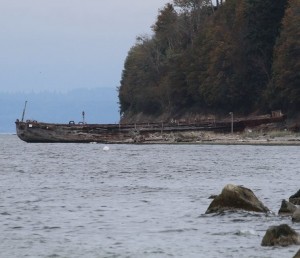 After Bob and I had the opportunity to view the old minesweeper, now located off Picnic Park near Edmonds, Washington, I have been curious about mines and minesweepers, in general. That said, I did a little research on them, and was surprised at what I found. Landmines have been in existence since the early Ming Dynasty in the 1400s. It seems such a strange thing to me to set explosives in areas where they could not only trigger an explosion when an enemy crosses paths with them, but they could also trigger explosions when their own citizens crossed paths with them. I suppose those accidental friendly hits would be considered collateral damage, and were acceptable losses in the grand scheme of things, but it still seems like a horrible way to guard an area. Still, it was definitely an effective way to guard and area, border, or waterway.
After Bob and I had the opportunity to view the old minesweeper, now located off Picnic Park near Edmonds, Washington, I have been curious about mines and minesweepers, in general. That said, I did a little research on them, and was surprised at what I found. Landmines have been in existence since the early Ming Dynasty in the 1400s. It seems such a strange thing to me to set explosives in areas where they could not only trigger an explosion when an enemy crosses paths with them, but they could also trigger explosions when their own citizens crossed paths with them. I suppose those accidental friendly hits would be considered collateral damage, and were acceptable losses in the grand scheme of things, but it still seems like a horrible way to guard an area. Still, it was definitely an effective way to guard and area, border, or waterway.
Nevertheless, I can understand why countries such as England, who is surrounded by water, and therefore vulnerable to certain types of attacks, especially during the earlier wars, like World War I and World War II, might have decided as they did in World War II, to lay mine traps to guard against movement by the German U-Boats in World War II. The U-Boats were feared by all their enemies, and considered one of the biggest dangers in the war by Winston Spencer Churchill. They made it almost impossible to have any prior knowledge of their presence, until it was too late to get away from them. Still, putting mines in the English Channel, where your own ships had to maneuver too, almost seems like taking a risk that would be greater than the benefit that it provided. Nevertheless, submarine traps were laid in the English Channel, and they served a purpose.
When considering a minesweeper in World War II, when ships were made of metal, I was curious as to why there would be a wooden hulled minesweeper in World War II. It has come to my attention that the minesweeper in Edmonds, may not have seen action at all. There seems to be a bit of confusion as to when it was built, and when it came to it’s final resting place in the Edmonds area. If it was indeed built for World War II, and never saw action, then my thought was why was it a wooden hull. I found the answer to that in my research on mines. There are several types of mines, as I mentioned earlier. Landmines were the earliest, but when it came to floating mines, they were mostly magnetic. Now when you put a metal minesweeper, or any other metal ship or submarine, near a magnetic mine…well, I’m sure you can get a picture of the seriousness of the problem they would have. A wooden hulled minesweeper on the other hand would have to actually come into contact with the mine to have that problem. Perhaps this was the reason for mines laid under the surface of the water and held in place by a cable. They were more invisible to the eye, and so created the ability to trigger the explosion when an unsuspecting ship or submarine found themselves in the wrong place. These mines blew a hole in the hull, rendering the ship or submarine helpless, as it took on water and quickly sunk.
There have been stories in the news over the years, of mines showing up on the shore years after they were 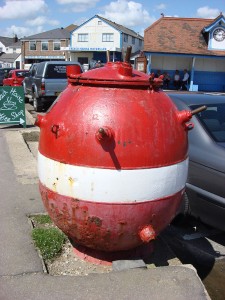 laid. It was a big problem, as were the landmines that were left after the wars. No clear record were kept apparently, and so removal of the mines was never made a priority. I remember when Princess Diana made it one of her priorities to find a way to get those landmines removed. The injuries to so many people who wandered into a minefield just tore at her heart. In hearing about the stories of tragedies resulting from those minefields, my mind cringed at the thought of those injuries. I found myself thinking that her quest to remove them was such an important one. Because I love to hike, I can see how easy it could be to create a trail that would cross paths with a minefield that has been around for decades. Sometimes, the necessary weapons of our warfare bring such destruction, that you find yourself wondering why people and nations can’t just get along, but we all know that is not to be. As long as there has been life on Earth, there have been wars of one kind or another, and I don’t expect that to change now, so these weapons will continue to exist and to be a big problem.
laid. It was a big problem, as were the landmines that were left after the wars. No clear record were kept apparently, and so removal of the mines was never made a priority. I remember when Princess Diana made it one of her priorities to find a way to get those landmines removed. The injuries to so many people who wandered into a minefield just tore at her heart. In hearing about the stories of tragedies resulting from those minefields, my mind cringed at the thought of those injuries. I found myself thinking that her quest to remove them was such an important one. Because I love to hike, I can see how easy it could be to create a trail that would cross paths with a minefield that has been around for decades. Sometimes, the necessary weapons of our warfare bring such destruction, that you find yourself wondering why people and nations can’t just get along, but we all know that is not to be. As long as there has been life on Earth, there have been wars of one kind or another, and I don’t expect that to change now, so these weapons will continue to exist and to be a big problem.
 A few days ago, I wrote about the United States Constitution, and how it was ratified by Massachusetts, with the condition that it be amended to include some rights that they felt were very important. On this day, September 25, 1789, those amendments were created. The first ten became the Bill Of Rights. These amendments would not be ratified until December 15, 1791. These days, there is some confusion and some complete ignorance as to the meaning of some of these rights…especially the first amendment. I can’t count the number of times that I have heard that according to the constitution, we are to have separation of church and state. That could not be further from the truth, and in fact would be an impossibility. The very idea that a person who holds political office could separate his or her religious values from their voting on matters concerning laws of the land is insane, and it is not what our forefathers meant when the Bill of Rights was created. The first amendment reads, “Congress shall make no law respecting an establishment of religion, or prohibiting the free exercise thereof; or abridging the freedom of speech, or of the press; or the right of the people peaceably to assemble, and to petition the Government for a redress of grievances.” All the first amendment…the part concerning religion, anyway…means is that Congress in not allowed to make a law saying that the United States is going to be one certain religion. England had such a law, and that was one of the main reasons the pilgrims left there.
A few days ago, I wrote about the United States Constitution, and how it was ratified by Massachusetts, with the condition that it be amended to include some rights that they felt were very important. On this day, September 25, 1789, those amendments were created. The first ten became the Bill Of Rights. These amendments would not be ratified until December 15, 1791. These days, there is some confusion and some complete ignorance as to the meaning of some of these rights…especially the first amendment. I can’t count the number of times that I have heard that according to the constitution, we are to have separation of church and state. That could not be further from the truth, and in fact would be an impossibility. The very idea that a person who holds political office could separate his or her religious values from their voting on matters concerning laws of the land is insane, and it is not what our forefathers meant when the Bill of Rights was created. The first amendment reads, “Congress shall make no law respecting an establishment of religion, or prohibiting the free exercise thereof; or abridging the freedom of speech, or of the press; or the right of the people peaceably to assemble, and to petition the Government for a redress of grievances.” All the first amendment…the part concerning religion, anyway…means is that Congress in not allowed to make a law saying that the United States is going to be one certain religion. England had such a law, and that was one of the main reasons the pilgrims left there.
Religion has been in the news a lot lately, and there have been many arguments about it. Which brings me to the next part of the first amendment “or prohibiting the free exercise thereof.” People don’t have to agree with my views on religion, but they are prohibited from telling me that I cannot express my religious views in speech, or on the internet. There are a lot of people telling other people that they have no right to talk or post about their religion, but they are completely wrong. We have every right to do so. Contrary to what some people might think, these rights are not negotiable…they are absolute. I can’t tell others not to talk about their religion, and they can’t tell me not to. It is the law.
As to “or abridging the freedom of speech, or of the press; or the right of the people peaceably to assemble, and to petition the Government for a redress of grievances”, we may not always agree with what people say, and sometimes it isn’t nice, but they have a right to speak. They have a right to give their opinion, whether others like it or not. By the same token, we have the right not to like what is said, and thereby we can decide not to like the person. That is our choice. The same applies to the press. That is the main reason why so many people just don’t believe a word some rag newspapers print. They can say what they want…true or not.
There are so many other violations of the Bill of Rights, that it would take a book to list them all, but I would really encourage everyone to get a copy of the Bill Of Rights, and find out for yourself exactly what is written there. Every time we allow our rights to be trampled on, we lose a little bit of the rights that we were intended to have through the Constitution and the Bill Of Rights. The longer those violations are allowed to go  on, the more people think that they understand their rights, when they really don’t, and so they end up giving their rights away. Our Constitution and the Bill Of Rights, and indeed, all the amendments to the Constitution, are so important to each and every one of us, and we need to know what is there, so that when some branch of the government steps on those rights, and someone speaks out about it, we don’t find ourselves on the wrong side of the issue. It really isn’t about whether or not we agree with the issue, but whether or not it is legal, because if the government will take away one right illegally, they will also take away another right illegally, and someday, they will get to one that affects you…but by then, it may be too late to stop an already runaway government.
on, the more people think that they understand their rights, when they really don’t, and so they end up giving their rights away. Our Constitution and the Bill Of Rights, and indeed, all the amendments to the Constitution, are so important to each and every one of us, and we need to know what is there, so that when some branch of the government steps on those rights, and someone speaks out about it, we don’t find ourselves on the wrong side of the issue. It really isn’t about whether or not we agree with the issue, but whether or not it is legal, because if the government will take away one right illegally, they will also take away another right illegally, and someday, they will get to one that affects you…but by then, it may be too late to stop an already runaway government.

